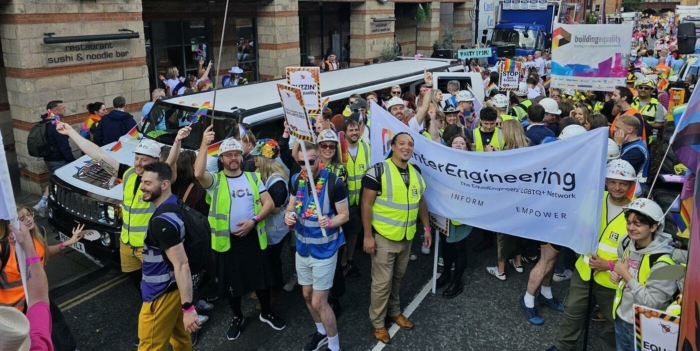 The decisions engineers make on a daily basis can have significant consequences for underrepresented and disadvantaged groups in society. Prof Dawn Bonfield, Visiting Professor of Inclusive Engineering at Aston University, Royal Society Entrepreneur in Residence at King’s College London and a member of the EPC’s Engineering Ethics Advisory Group explains…
The decisions engineers make on a daily basis can have significant consequences for underrepresented and disadvantaged groups in society. Prof Dawn Bonfield, Visiting Professor of Inclusive Engineering at Aston University, Royal Society Entrepreneur in Residence at King’s College London and a member of the EPC’s Engineering Ethics Advisory Group explains…
In the recent ethics report published by the RAEng (1) you might have noticed the explicit references, in an ethics context, to the societal and social justice implications of our engineering solutions that can lead to biased or discriminatory outcomes for different groups of people. This prioritisation of inclusive outcomes is a welcome expansion of the conventional focus of engineering ethics, which is often rooted in issues such as safety, corruption, and competence.
Reference was made in the first page of the report to the use of crash test dummies that have been designed to represent male drivers, leaving women (and pregnant women in particular) at greater risk in car accidents; the potential for algorithms and internet search engines to influence our thoughts on the world; issues arising from facial recognition technology failing to accurately identify those from Black, Asian and Ethnic Minority communities; and the use of artificial intelligence systems that will make safety-critical, legal, and other life changing decisions, which are often based on historical and biased datasets. You can further explore some of the issues with facial recognition technology in one of the ethics case studies produced by the EPC for their RAEng-supported Engineering Ethics toolkit.
These are all examples of how, as engineers, we can inadvertently create solutions that are biased against minoritized groups of people if we are not careful. This generally occurs as a direct result of the fact that these groups of people are poorly represented in the engineering sector, and so their inputs are missing in the specification, design, and testing of new technologies (2).
But even before we get to a truly diverse engineering workforce, all engineers must be mindful of the ways in which the decisions they take can be discriminatory or can promulgate bias. In situations like the ones mentioned above it is relatively easy to spot the opportunity for discrimination, but in other cases it can be much more difficult. For example, there are ethical implications associated with the sort of ducting that gets chosen for a new building, where one material causes more pollution to socially and economically disadvantaged populations than another. It is in cases like this that a little more thought is required to spot whether the outcomes of these decisions are inclusive and ethical, or not.
Recently, the Covid-19 pandemic has shown us very clearly what the ethical implications are of our built environment decisions and designs, where people living in densely populated and overcrowded urban areas with minimal access to outdoor space have had significantly worse health outcomes than those with access to outdoor and green spaces. Inclusive design of the built environment is now a growing and recognised area of our engineering work, and as well as the more obvious examples of ensuring equitable access to those with disability issues, it also recognises that public spaces should be equitable and accessible to all communities. Everybody needs to see themselves represented in these environments and feel able to use them safely and fully. These are issues of ethics and inclusion, as well as social justice and equality, and the requirement we have as engineers to consider all of these perspectives as the creators of our future world must be a part of our systems engineering mindset. Several of the EPC’s ethics case studies focus on responsibility, equity, and stakeholder engagement, such as the Ageing Pipeline and its Impact on Local Communities case.
The importance of systems, design, iterative thinking, and the focus on ensuring that the whole life cycle of a product, including maintenance, repair, deconstruction, and end of life decommissioning, requires true stakeholder engagement, means that these inclusive outcomes can be considered at the very start of projects, rather than as an afterthought, where any changes are much more difficult and costly to integrate. The strengthening of the Social Value Act (3), which requires people who commission public services to explicitly evaluate how they can secure wider social, economic and environmental benefits, also puts emphasis on ensuring the outcomes of any procurement are inclusive and ethical. Similarly, the Sustainable Development Goals ethos of Leave No One Behind (4) requires that outcomes are considered from all perspectives, and that solutions taking all of the goals into account are balanced and not considered in silos. The EPC’s ethics case study on Business Growth Models allows engineering students to explore many of these issues.
Designing with the gender perspective in mind, especially in parts of the world where women have very different societal roles based on culture, stereotypes, local norms, and religion, is key to ensuring that the differences and disadvantages that women face are not exacerbated. Understanding these differences is the first step in addressing them, and in many cases, technology can act as a real enabler in situations where women have limited access to traditional education, information, and independence. For example, the widespread use of microfinance in many parts of Africa – a technology not aimed specifically at women – is nevertheless giving women much better access to loans and financial independence than the traditional banking structures did, which women are not always able to access easily. Other examples include understanding the need for sanitation facilities in public spaces such as schools, government offices, transportation hubs and health clinics, without which women’s access to these facilities becomes restricted and their participation curtailed (5).
Another ethical issue comes into play here too. Do we design just to remove bias and discrimination, or do we design to reverse historical bias and discrimination? For example, women have traditionally worked in certain sectors such as care giving roles, and not in sectors like engineering and technology. Algorithmic decision-making tools can use this historical data to preferentially show stereotypical job opportunities based on past trends and evidence, which could foreseeably prevent women from being targeted for engineering related roles. Adapting these tools to make these job opportunities open to all in an equitable way is one thing, but what if we decided to preferentially show engineering roles to women and caring roles to men – a kind of social engineering, if you will? What are the ethics of this, and would that be going too far to remove biases? I will leave you to think about this one yourselves! If you would like to write a case study about it, we are currently looking for contributors to the toolkit!
The decisions we make daily as engineers have consequences to individuals and communities that have not always been understood or considered in the past, but by understanding the need for inclusive outcomes for all stakeholders, we also ensure that our solutions are ethical, and that we leave no on behind. The ethics case studies in the EPC’s recently launched Engineering Ethics Toolkit reveal the ethical concepts that comprise our everyday activities and what lies behind those decisions – resources like this should be used to ensure ethical decision making is integrated throughout an engineers’ education and continuing professional development.
This blog is also available here.
References
- RAEng Ethics Report https://raeng.org.uk/policy-and-resources/education-policy/the-engineering-profession/global-responsibility-and-progressive-engineering-leadership/ethics
- inceng.org website
- Social Value Act https://www.gov.uk/government/publications/social-value-act-information-and-resources/social-value-act-information-and-resources
- Sustainable Development Goals ethos of Leave No One Behind https://unsdg.un.org/2030-agenda/universal-values/leave-no-one-behind
- Towards Vision Website ‘Gender Perspective in Engineering’ http://www.towardsvision.org/the-gender-perspective-in-engineering.html
Dawn Bonfield MBE CEng FIMMM FICE HonFIStructE FWES is Visiting Professor of Inclusive Engineering at Aston University and Royal Society Entrepreneur in Residence at King’s College London.
This blog is also available here.
Any views, thoughts, and opinions expressed herein are solely that of the author(s) and do not necessarily reflect the views, opinions, policies, or position of the Engineering Professors’ Council or the Toolkit sponsors and supporters.

 The decisions engineers make on a daily basis can have significant consequences for underrepresented and disadvantaged groups in society. Prof Dawn Bonfield, Visiting Professor of Inclusive Engineering at Aston University, Royal Society Entrepreneur in Residence at King’s College London and a member of the EPC’s Engineering Ethics Advisory Group explains…
The decisions engineers make on a daily basis can have significant consequences for underrepresented and disadvantaged groups in society. Prof Dawn Bonfield, Visiting Professor of Inclusive Engineering at Aston University, Royal Society Entrepreneur in Residence at King’s College London and a member of the EPC’s Engineering Ethics Advisory Group explains…


